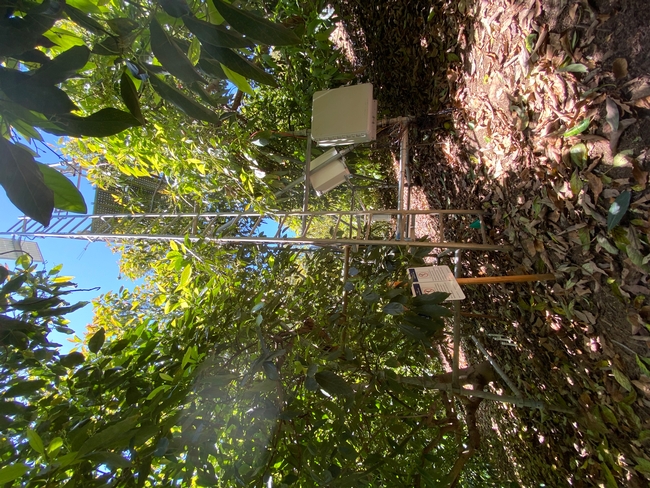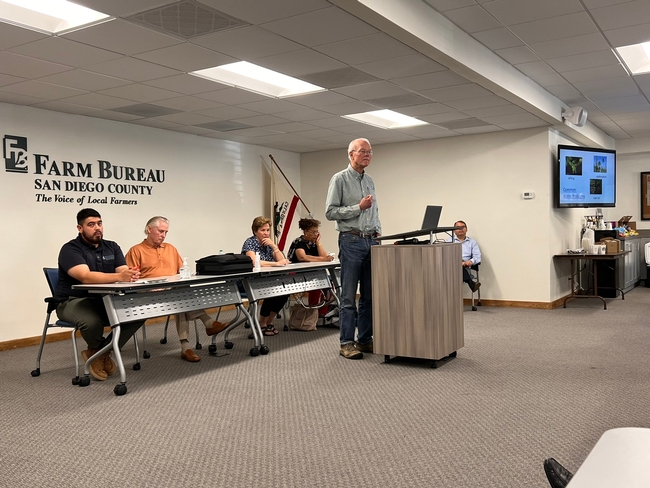
San Diego avocado growers look to Cooperative Extension experts to manage water costs
San Diego County used to be home to nearly 25,000 acres of avocado trees but today there are about 14,000. The drastic decrease is largely due to rising costs associated with avocado production, namely the cost of water.
On September 28, avocado growers gathered at the San Diego County Farm Bureau offices for an Avocado Irrigation Workshop facilitated by Ali Montazar, University of California Cooperative Extension irrigation and water management advisor for Imperial, Riverside and San Diego counties.
“All of our information being developed right now is focused on [irrigation] efficiency. Growers want to know how much water they need and what tools they should use to be more efficient,” explained Montazar.

“The sophisticated research in avocado irrigation that Dr. Ali Montazar is conducting is the first of its kind that the University of California has carried out specifically in avocados. His presentation allowed us attendees the opportunity to see and learn about the technology he is employing – from soil moisture sensors to the California Irrigation Management Information System level equipped station.”
Burr is hopeful that Montazar's research will help avocado growers accurately determine the evapotranspiration in an avocado grove or water use specific to avocados, critical parts of how growers select tools to determine irrigation runtimes.
“His presentation that showed his research finding of the avocado Kc (crop coefficient), while very early into his project, was really interesting. It indicates the possibility that we may need to vary the Kc for different times in the growing season, but he is just beginning a two-to-three-year project that will hopefully deliver solid data on what the Kc for avocados is,” said Burr.
Colorado River uncertainty looms
San Diego's avocado production is primarily managed by small farms. According to Montazar, this adds a level of complexity to water management because there is a greater emphasis on irrigation tools and strategies being user-friendly and cost-efficient.
“We don't know the future,” said Montazar. “But we need to be prepared for all consequences. The Colorado River is experiencing a significant water shortage, and this could impact the water supply source for San Diego County from the Imperial Irrigation District Transfer in the future. It is wise to consider enhancing irrigation efficiency as the most viable tool to manage limited water supplies in Southern California.”
Water has always been an issue. In the 1970s, California's water program paved a way for an additional 98,000 acres of agricultural land.
According to a 1970 study analyzing the cost of avocado production in San Diego County, water costs “averaged 3½ acre feet per acre at $60 an acre foot,” which came with the assumption that water costs would remain relatively low and affordable for a long time.
Unfortunately, that is no longer the case. The county of San Diego gets the majority of its water from the Colorado River, which is concerning given five-year projections of the river reaching critically low reservoir levels by 2027.
In fact, beginning in 2023, the San Diego County Water Authority will be raising the rates for water, prompting growers to invest in more efficient irrigation practices (Table 1).
Table 1. Cost for untreated and treated water in San Diego County in 2022 and 2023.
NOTE: An acre-foot is about 325,900 gallons of water.
Training growers on irrigation a top priority
There are no loopholes or short cuts when it comes to irrigation because irrigation is the key to tree health. Ben Faber, Cooperative Extension subtropical crops advisor for Ventura and Santa Barbara counties, points out that tree health is how growers stay in business.
“You can mess up your fertilization program, and you can mess up your pesticide program, but if you mess up your irrigation program, you're out of business,” he said.
According to Faber, efficient irrigation requires a strong grasp on salt management.
“We import water that has a lot of salt in it. So, you've got to figure out how to put the right amount of water on the root zone without causing root health problems,” said Faber.
This process requires meticulous care, as anything that gets below the root zone can cause groundwater contamination – something growers do not want to be responsible for.
While the latest irrigation technology, such as smart controllers, could help growers, Faber said that training and educating farm managers should be the priority.
As Faber puts it, managing irrigation should be “like brushing your teeth” – something that growers do naturally and competently. Many growers are over-irrigating or wasting time trying to resuscitate dying trees. It's important to learn the needs of the tree and, in some cases, it might be best to stop watering all together.
The first step to water efficiency is acquiring knowledge and identifying needs. Because an over-irrigated tree looks just like an under-irrigated tree, it's crucial that growers learn to recognize the difference and plan accordingly.
This is where Cooperative Extension advisors and researchers come in. Opportunities like the Avocado Irrigation Workshop are ideal for growers looking for answers or support.
For more information and to learn about future workshops in San Diego County, visit https://cesandiego.ucanr.edu/.


